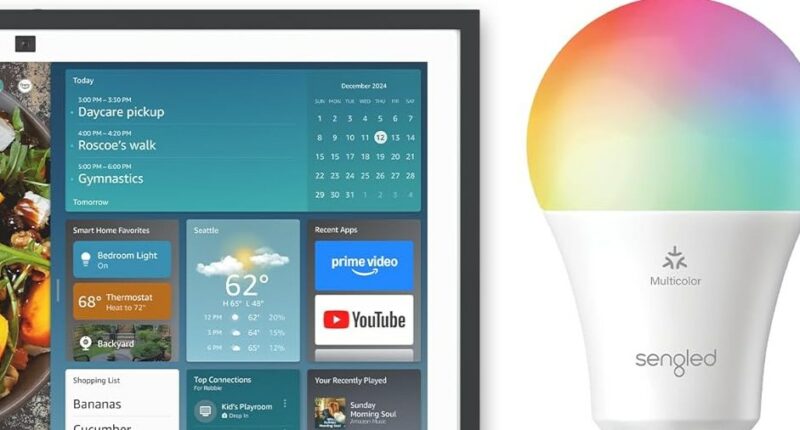Share this @internewscast.com
Following repeated episodes of leaving consumers without proper smart control over their lighting systems, Sengled has been removed from Amazon’s Works With Alexa program. As initially reported by TechHive, from August 1st, users can no longer access Sengled’s Alexa skill for managing their selection of LED lights, plugs, switches, and sensors with voice commands and routines.
In an explanation to The Verge outlining the decision, Amazon’s spokesperson Lauren Raemhild stated, “We maintain a high standard for the Alexa experience. Sengled has faced continuous outages in recent months that remain unresolved, hindering customers’ ability to utilize Sengled’s Alexa skill to manage their light bulbs.”
The future appears dim for Sengled, which has remained silent since issues began surfacing earlier this summer. There has been no communication regarding these problems from the company (though Amazon has notified its customers about the outages), nor is there an acknowledgment on its website. Numerous attempts by The Verge to reach out to Sengled have gone unanswered.
If your Sengled bulbs were Wi-Fi, you’re out of luck.
However, there is some positive news. If you possess Sengled bulbs that utilize Zigbee, BLE Mesh, or Matter instead of Wi-Fi, they can still be used with Alexa by bypassing Sengled’s unreliable servers and linking to a compatible Echo speaker or Eero Wi-Fi router (this might necessitate a setup redo). Alternatively, you can connect Zigbee bulbs to third-party hubs that support the protocol, such as Home Assistant, Hubitat, or the Aeotec SmartThings hub.
But if your bulbs are Sengled’s Wi-Fi variant, you’re unfortunately out of luck. They won’t connect to Alexa anymore, although they will continue operating with Sengled’s app, as long as Sengled’s servers remain active. Users have begun to report issues there as well, underscoring the vulnerabilities tied to depending on cloud services for lighting solutions.
We’ve witnessed this narrative too frequently in the smart home realm. Just last month, Belkin closed its WeMo smart home operations, and the smart home landscape is marked with other similar tales: iHome, Revolv, Staples Connect, Lowes’ Iris, Best Buy’s Insignia, and more.
A common thread with these shutdowns is that the products relied on cloud servers. At one time, it was easier and less expensive for a company to develop a cloud-based controller than a local system, as they don’t require a hub or bridge and can be simpler to set up and use.
However, companies have to maintain those servers, as well as API connections to smart home platforms and voice assistants like Alexa and Google Assistant, which can be costly and resource-intensive. When the business model no longer pans out, history shows us that if they can’t sell it, companies just shut it down.
This brings me to my best piece of advice to anyone buying a smart home device today, especially something as integral as lighting: make sure it has the option of local control. That way, if the company goes under or stops providing the service you signed up for, then your device will still keep working (in some fashion). Plus, locally controlled devices tend to be faster, as they don’t have to wait for a response from a server.
Relying on cloud services to turn your lights on is a fragile solution.
As noted, some Sengled bulbs don’t rely on a cloud connection and instead can work locally in your home. Thanks to a connection via local protocols like Apple’s HomeKit or Zigbee, some products from those companies listed above also still work, even though their servers are gone.
That’s one of the reasons why the new Matter standard is so crucial to the smart home. While it has had its problems, Matter is built on the foundations of HomeKit, Zigbee, and other technologies. It’s an entirely local protocol, communicating to a Matter controller (hub) in your home, not to a company’s cloud.
While Matter ecosystems such as Apple Home, Google Home, Amazon Alexa, and Home Assistant can connect to the cloud to give control when you’re away from home and enable other features like voice assistants, that’s a layer on top of Matter. If a device like a smart bulb supports Matter, either over Wi-Fi or Thread, you don’t need the internet to turn on the lights. And, if the manufacturer’s server dies, your device won’t.
Matter isn’t the only option here. Devices that work over Zigbee, Z-Wave, BLE and BLE Mesh, and local Wi-Fi, also offer local control. But the standardization of Matter, its wide industry support, and its use of non-proprietary IP-based protocols Matter and Thread all broaden its overall compatibility and should make it more futureproof.
The situation with Sengled is just the latest reminder that for a truly reliable smart home, look for local control. While the cloud offers benefits, it should be part of your solution for a smarter home, not the only one.
Developed by Apple, Amazon, Google, Samsung, and others, Matter is an open-sourced, IP-based connectivity software layer for smart home devices. It works over Wi-Fi, Ethernet, and Thread.
Thread is a low-power, wireless mesh protocol. It operates on the same 2.4GHz spectrum as Zigbee and is designed for low-power devices, such as sensors, light bulbs, plugs, and shades. IP-based, Thread devices can communicate directly with each other, the internet, and with other networks using a Thread Border Router.
Today, Matter supports most of the main device types in the home, including lighting, thermostats, locks, robot vacuums, refrigerators, dishwashers, dryers, ovens, smoke alarms, air quality monitors, EV chargers, and more.
A smart home gadget with the Matter logo can be set up and used with any Matter-compatible ecosystem via a Matter controller and controlled by more than one ecosystem with a feature called multi-admin.
Amazon Alexa, Google Home, Samsung SmartThings, Apple Home, Home Assistant, Ikea, and Aqara are among the well-known smart home companies supporting Matter, along with hundreds of device manufacturers.








